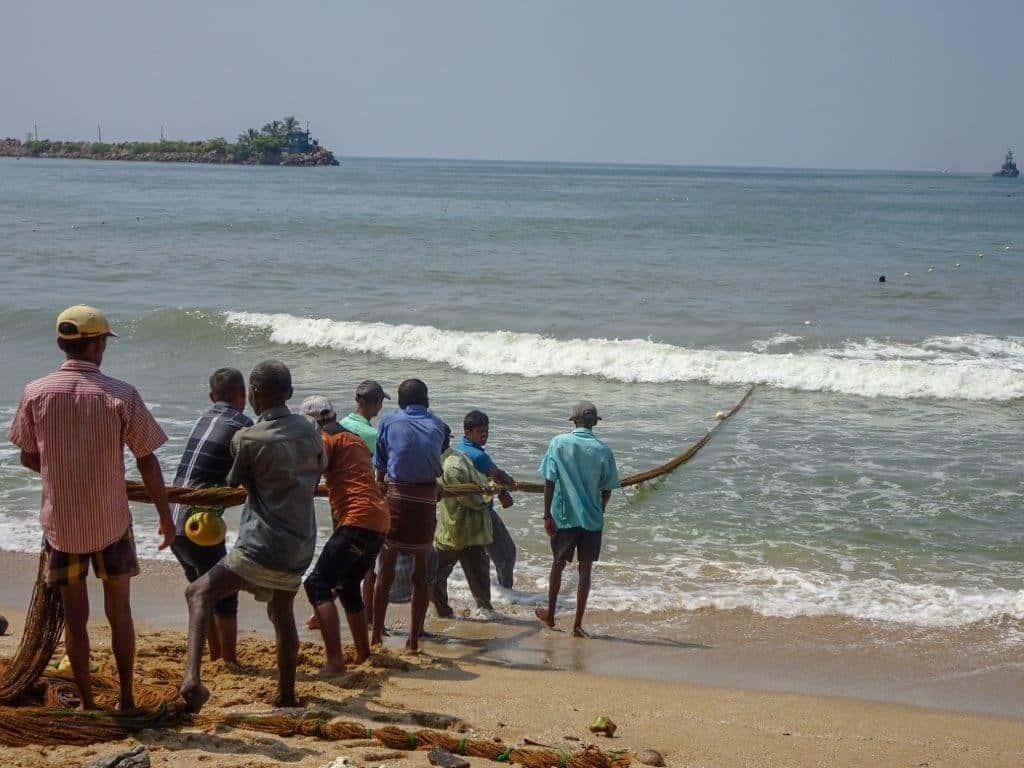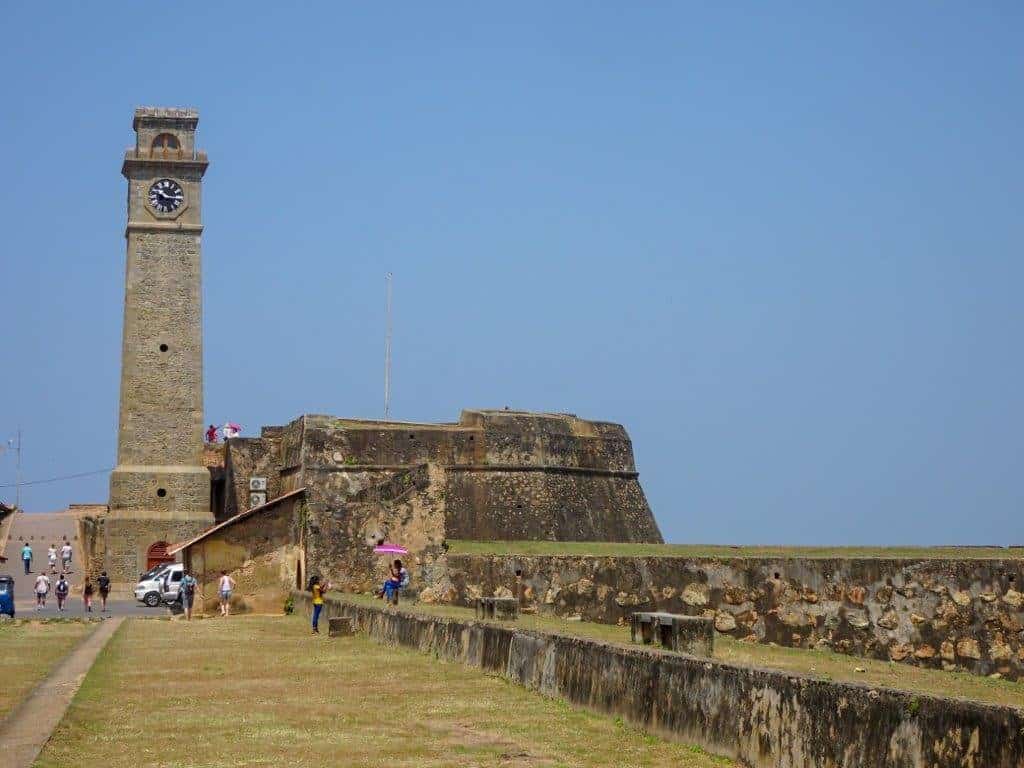Updated October 2019
A leisurely start this morning after an exciting safari yesterday.
Our 7-day itinerary of Sri Lanka seemed to get better with each new day. And now we were off to the beach to dip our toes into the Indian Ocean.
For the next two days of our itinerary, we would visit Mirissa Beach, Galle Fort, and Colombo.
Because of the season, Mirissa Beach on the southern coast is a popular beach to relax and unwind. So leaving Tissamaharam near the Yala National Park, our first stop was inland at Dickwella.
Two-Day Tour of Mirissa Beach, Galle Fort, and Colombo
When you have your own driver on a 7-day itinerary of Sri Lanka, you get the local knowledge of Sri Lanka.
For the next two days, we would explore the southern coast of Mirissa Beach and Galle Fort before arriving in the capital city of Colombo.
But on the way, we also got to see other places of interest in Sri Lanka.
Visit Wewurukannala Buduraja Maha Viharaya
First, a stop at Budu Raja Maha Wehera Wewurukannala, Dickwella, to view a 350-year-old shrine, one of the largest Buddha statues in Asia.
There is a small entrance fee to enter the grounds and temple.
If you start at the temple, you’ll find beautiful frescos telling a story of enlightenment. Then it’s a walk through the Tunnel of Hell to reach the 50m-high seated Buddha.
This tunnel (hall) has hideous life-size figures depicting horrific scenes. It is to show what happens when you succumb to temptation rather than taking the path to enlightenment.
Not quite what we were expecting. And if you are travelling with children, we suggest not visiting this temple.
Thankfully the next stop is full of energy.
Visit the Two Forts of Matara
Our road trip to Mirissa Beach passed through Matara for a stop at Star Fort Matara.
Arriving in the city, a local school cricket team was gearing up for a match later in the day. A lot of noise, happy faces and young men hanging out of or on top of vehicles chanting and waving flags.
See Inside Star Fort Matara and Matara Fort Star
Matara on the Nilwala River was an important port for traders of cinnamon and elephants.
Matara Fort was built by the Portuguese in 1560, updated by the Dutch in 1640 and rebuilt by the British in 1796.
The British built a clock tower in 1883 on the remaining rampart.
We stopped for a look around the Star Fort Matera on the eastern bank of the Nilwala River. It is a six-pointed star shape built by the Dutch in 1763 to protect the Matara Fort.
Going through the beautiful entrance gate gives you an idea of the 7.5-meter outer walls. The walls are made of granite and coral and hold 12 canons to face all directions.
Seeing how close we were to the coast, we couldn’t wait to have a swim at Mirissa Beach.
Mirissa Beach is the Perfect Spot for a swim

Our accommodation at Giragala Village on Mirissa Beach beachfront reminded us of being in a motor camp.
With the sea as our pool in this surfing bay, we went to cool off as temperatures were once again in the early 30s.
Along the beachfront, there are plenty of casual bars and restaurants. In the evening, after sunset, you can find a few unsupervised bonfires ready for party-goers.
We dined at Giragala Village on seafood dishes bought from the village.
With the manager, we selected Kingfish and calamari, which he cooked to perfection. We dined under the coconut trees savouring our delectable dishes of seafood.
Only a short stay at Giragala Village with enough time for a walk before breakfast on the outcrop of Parrot Rock.
If you are staying longer at Mirissa Beach between November and April, book a whale watch excursion. From March to April, the famous Blue Whale swims the coastal waters.

Fishing Villages of Sri Lanka

A tourist thing to do is to watch the men fishing from large poles out from the beach. They don’t fish but pose for photos for a fee.
To see fishermen in action, we stopped at a local fish market.
Fishing is the livelihood of those living along the coast. And when you see a group of villagers hauling in the net from the mornings fishing. It makes you appreciate how hard some people work to make a living or an existence.
If you want to learn more about Misissa Beach, you can check out this website Mirissa Beach.
Walk the Walls and Streets of Galle Fort

Galle Fort was built by the Portuguese in 1584 and fortified by the Dutch during the 17th century. But in 1796, the British held the fort.
Galle Fort was built on a peninsula, making it the main port for ships sailing between East and Europe.
Galle Fort is now a UNESCO site, and thanks to a lot of restoration work, it withstood the Boxing Day Tsunami.
Entering the fort is through the impressive gates. There is an area for cars to park because, through the second gate, the 52 hectares of Galle Fort is pedestrian-friendly.
You can either walk around the wall with views across the sea. As well as seeing young Sri Lankan couples making out under their umbrellas along the ramparts.
Or walk within the walls of Fort Galle, where the streets are void of cars as you wander past the exquisite colonial buildings. Some are now used for restaurants or boutique shops.
What is impressive is the iconic lighthouse of Galle Fort towering above.
Devastation at Tsunami Memorial Honganji Viharaand

When the Boxing Day Tsunami of 2004 hit the shores of Sri Lanka, 50,000 people were killed.
Stopping at the Tsunami Memorial Honganji Vihara, we visited a small photo gallery museum. The photos showed the destruction of the second wave in this area of Sri Lanka.
The Tsunami Memorial Honganji Vihara was built to a height of 18 meters. It matches the height of the second tsunami wave through this area.
And behind the statue is where the 18-meter wave hit a train claiming 1,700 lives.
Further up the road is another memorial, the Peraliya Tsunami Memorial to the villagers who lost their lives on this tragic day.
Taking the Inland Road to Colombo
Heading inland, we passed by low-level tea, rubber and palm oil plantations. We also kept seeing signs of moonstone mines. The beautiful sapphires we saw in Kandy are also mined in this area.
At last, we emerged from the plantations to travel along the A2, a four-lane highway built by the previous President. No more narrow, winding roads.
We pulled in at a new highway rest area to purchase a tasty and inexpensive lunch before the last hour’s drive to Colombo.
We even got to meet our driver’s parents at their home for afternoon tea. Only because Maura had left earrings in Sirigiya Cottage, which were sent to Colombo.
We enjoyed Sri Lankan coffee and sweet cakes. We also tried Sour Sop, a fruit similar to a Custard Apple we had eaten in Queensland. It’s very delicious, like vanilla ice cream.
Visiting Colombo, the capital of Sri Lanka
The capital city of Sri Lanka and Nistanha’s home town. His knowledge of the back roads came in handy to avoid traffic as we went to view the various sights of the city.
Colombo has a long history as a port on ancient east-west trade routes, ruled successively by the Portuguese, Dutch and British. That heritage is reflected in its architecture.
Top Things to Do in Colombo
Parliament Buildings at Kotte – this is a new style of architecture for the Houses of Parliament. Built on an artificial island on the lake of Diyawanna Oya.
Gangaramaya Temple – is more akin to a curiosity shop than a temple. One of the monks was a keen collector of antiques, so there were old typewriters and pianos stacked along the fences. And inside, we saw collections of china and remains of a mummified elephant.
Independence Memorial Hall and Independence Square – were built to commemorate independence from British rule in 1948. We found it a popular place with lots of people taking shade from the afternoon sun. You can also walk around the Cinnamon Gardens or the underground Independence Memorial Museum.
A statue of D.S. Senanayake, Sri Lanka’s first prime minister, surrounded by four stone lions, is prominent when you first see the Memorial Hall. He was responsible for the stunning architecture of this building.
Viharamahadevi Park and the Giant Buddha – is the oldest and largest park of Colombo. In 1972, a 4.5-meter brass Samadhi statue of Lord Buddha was erected in the park.
Nelum Pokuna Auditorium in Sri Lanka – is the performing arts centre. The building takes its shape from the eight-petalled lotus flowers of Polonnaruwa ancient city. The total floor area is 14,000 square meters.
The National Museum of Colombo – is also known as the Colombo Museum and was founded in 1877. It is the largest museum in Sri Lanka within a stunning 19th-century building.
Jami-Ul-Alfar Mosque – Built between 1908-1909, the mosque was built by the Indian Muslim community. What makes it unusual is the red and white striped exterior.
Pettah Market – Any visit to a city needs to include a market. The Pettah Market has everything, including massive crowds of people, noise, hustle, and bustle.
Visit Colombo Fort for Exquisite Architecture
The area known as Colombo Fort has an old history with stunning buildings of:
- Old Parliament Building – a stunning Neo-Baroque building is now used by the Presidential Secretariat of Sri Lanka
- President’s House – originally the British Governor Generals House
- General Treasury – original the Secretariat Building
But it is also the financial district of Sri Lanka with modern architecture mixed in with the old. The Old General Post Office is a classic, as is the Old Colombo Dutch Hospital.
Old Colombo Dutch Hospital – is one of the oldest buildings in Colombo. It’s now used for boutique restaurants and shops.
Galle Face Esplanade
One of the best evening things to do in Colombo is to stroll along the busy foreshore of Galle Face. Here you’ll see families enjoying a swim in the crashing waves. While others watch the sunset or enjoy one of the many food stalls lined along the esplanade.
At sunset, the Sri Lankan flag is lowered, the appropriate way we thought for a great day exploring Colombo.
Visiting the Best of Mirissa Beach, Galle Fort, and Colombo
We were on a 7-day itinerary of Sri Lanka, so our two days exploring Mirissa Beach, Galle Fort and Colombo were spectacular.
Mirissa Beach is a popular beach to relax and enjoy swims, whale watching, and glorious sunsets. You can eat fresh seafood caught daily and visit fishing villages along the coastline.
Galle Fort is perfect for a two-night stay with its boutique restaurants, hotels, and shops. Just over two hours from Colombo, Galle Fort gets you away from the busy capital city.
Colombo is a vibrant city with an interesting history which you can see in its old and modern architecture. You can visit the amazing Pettah Market and beautiful gardens of Independence Square or stroll along the beach promenade.
When looking for a different Asian experience, Sri Lanka is a country with charm. when you book a flight to Sri Lanka, you can discover the best things about Colombo, Galle Fort, and Mirissa Beach.

Good holiday venue .Love the more exotic views and the warm ocean
It was a lovely spot to relax, also some historical sites nearby, well worth a visit.